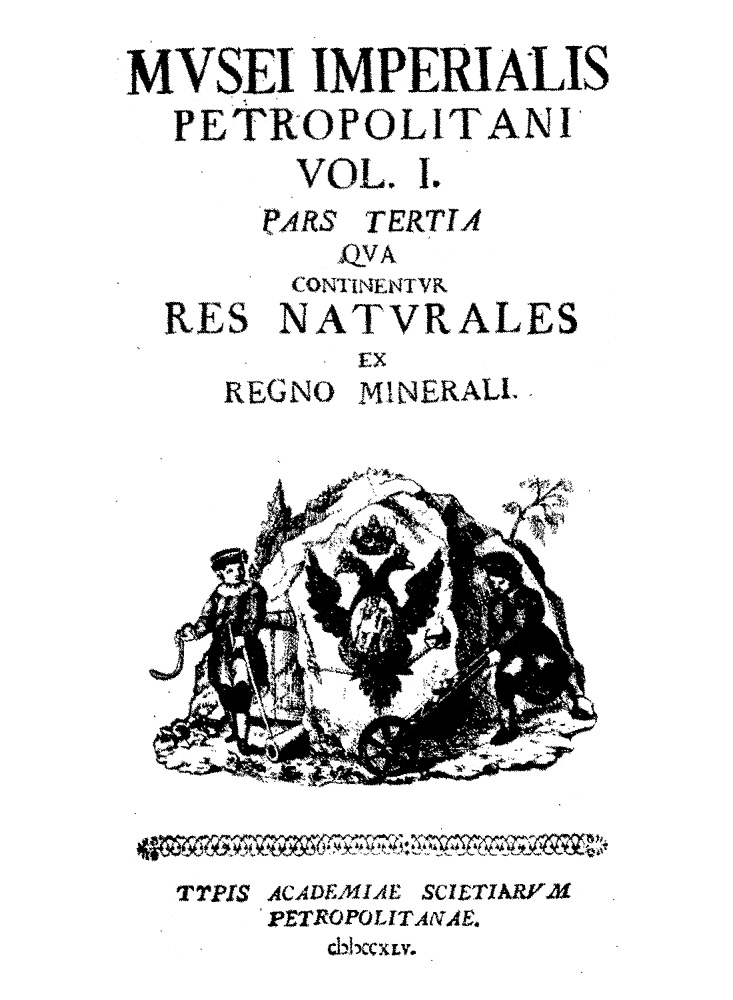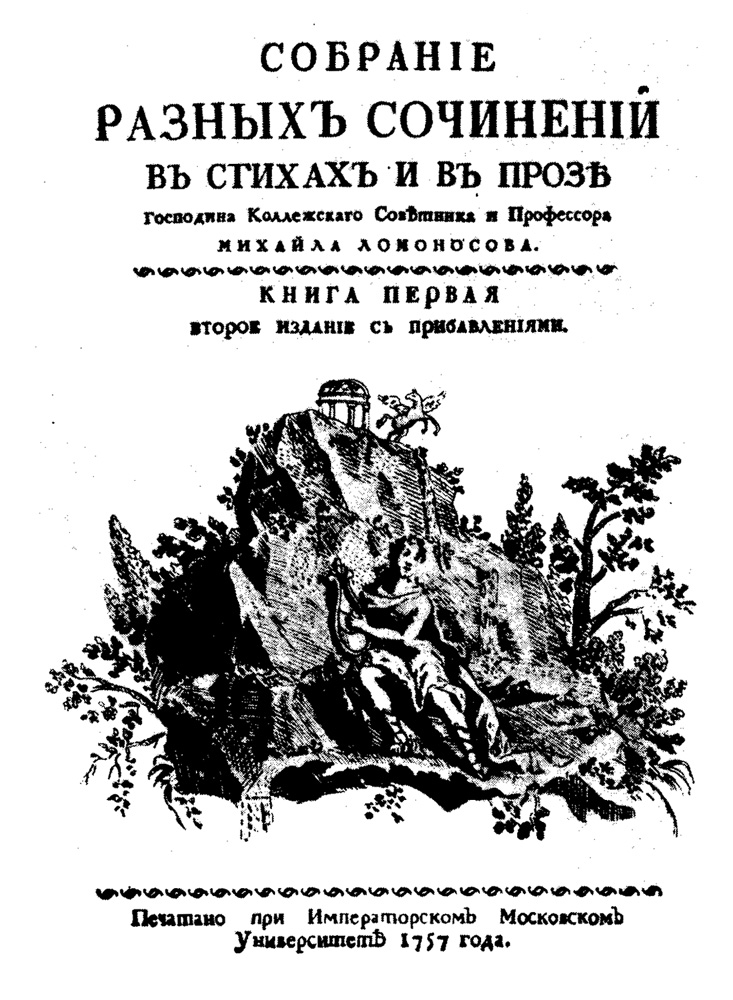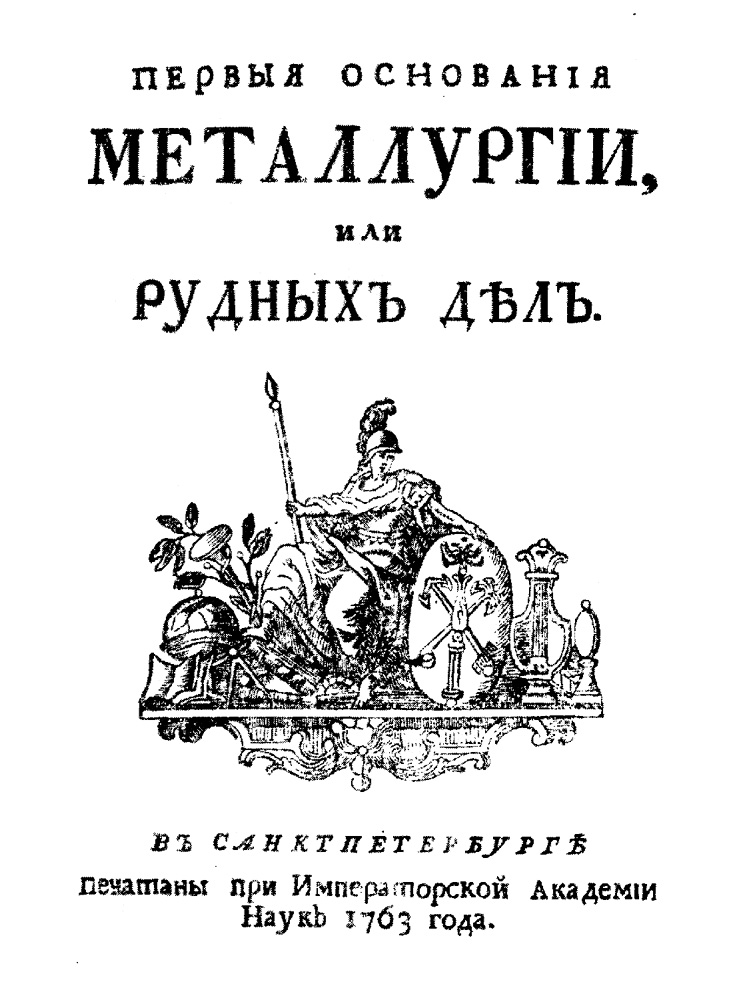LOMONOSOV, Mikail Vasilievich.
(1711 – 1765)
Lomonosov's father was a farmer and fisherman, and as a youth he travelled the northern seas. Early on he learned to read and write. In 1730, he travelled by foot to Moscow where he studied ancient languages in the city's academy. In 1736 having shown himself to be one of the best students, he was first sent to the St. Petersburg Academy of Science and then for three years to Marburg University in Germany where he was instructed by the philosopher Christian Wolff [1679-1754]. In 1739, Lomonosov travelled to Freiberg in Saxony to work in the laboratory of Johann Friedrich Henckel. There he became immersed in problems of mineralogy, mining and metallurgica chemistry. He returned to St. Petersburg in 1741. Lomonosov was made an associate professor of physics at the academy in 1742, followed by a professor of chemistry in 1748. From this post, he opened in 1745 the first chemical laboratory in Russia, and in 1758 became director of the geographical department.
Through out his carrer at the St. Petersburg Academy, Lomonosov was continuously fighting the imported European scientists to make Russia a true scientific power. His believe was that his homeland was the equal of any country in Europe, but the dominance of foreigners on the committee disregarded his patriotic views.
Biographical references: Anon., Michaeil Wassiljewitsch Lomonossow (1711 bis 1765). Leipzig, 1983. 137 p., 11 illus., map. [Published as: Freiberger Forschungshefte. D 157; Commemeration of Lomonosov's 270 birthday.]. • Barr, Index to Biographical Fragments, 1973: 160. • DSB: 8, 467-72. • Encyclopaedia Britannica, 11th edition. • Great Chemists: 201-210, portrait. • ISIS, 1913-65: 2, 108-11. • Lambrecht & Quenstedt, Catalogus, 1938: 267. • Moliavko, Geologi Biograficheskii, 1985: p. 162-4. • Pavlova, G.E. and A.S. Fedorov, Mikhail Vasilievich Lomonosov: his life and work. Edition revised from the 1980 Russian edition. Translated by A. Aksenov. Moscow, Mir, 1984. 312 p., illus. • Poggendorff: 1, cols. 1493-4. • Sarjeant, Geologists, 1980: 3, 1597-8, Suppl. 1 (1986), 2, 602 & Suppl. 2 (1995), 2, 851. • World Who's Who in Science: 1062. • Zvorykin, Biograficheskii Slovar, 1958: 1, 529-36, portrait.

1. Latin, 1741-5 [Collection catalog].
Mvsei Imperialis | Petropolitani | Vol. I. | Pars Tertia | Qva | Continentvr | Res Natvrales | Ex | Regno Minerali. | [vignette] | [ornate rule] | Typis Academiae Scietiarvm | Petropolitanae. | cI[Backwards c]I[Backwards c]ccxlv.
6 parts in 2 vols. [Vol 1, pars 1: 1742] 8°: )(4 A-Mmm8 Nnn2; ??l.; [8], [1]-755, [1] p. (Pars prima qua continentur res naturales ex regno animali. Petropolitanae, Acad. Scientiarum, 1742.) [Vol 1, pars 2: 1745] 8°: π1 A-Tt8; ??l.; [2], [1]-636, [16] p. (Pars secunda, qua continentur res naturales ex regno vegetabili. Petropolitanae : Acad. Scientiarum, 1745.) [Vol 1, pars 3: 1745] 8°: π2 A-O8 P2; ??l.; [4],[1]-227, [1] p. (Pars tertia, qua continentur res naturales ex regno minerali. Petropolitanae, Acad. Scientiarum, 1745.) [Vol 2, pars 1: 1741] 8°: π2 a-q8; ??l.; [4], [1]-212 p. (Pars prima, qua continentur res artificiales. Petropolitanae, Acad. Scientiarum, 1741.) [Vol 2, pars 2: 1745] 8°: π1 r-hhh8 ggg6; ??l.; [2] p., p. [213]-796 (i.e.,784), [3] p. (Pars secunda qua continentur Nummi antiqui. Petropolitanae, Acad. Scientiarum, 1745.) [Vol 2, pars 3: 1745] 8°: π1 a-bb8 χ1; ??l.; [2], [1]-477, [3] p. (Pars tertia, qua continentur nummi recentiores. Petropolitanae, Acad. Scientiarum, 1745.)
Contents: [Vol 1, pars 1] [2 pgs], Title page, verso blank.; [6 pgs], "Syllabus | Thesavrorvm Anatomicorvm." (=table of contents).; [1]-755, Text.; [1 pg], Blank.
[Vol 1, pars 2] [2 pgs], Title page, verso blank.; [1]-636, Text.; [16 pgs], "Index."
[Vol 1, pars 3] [2 pgs], Title page, verso blank.; [1 pg], "Syllabvs."; [1 pg], Blank.; [1]-227, Text.; [1 pg], Blank.
[Vol 2, pars 1] [2 pgs], Title page, verso blank.; [1 pg], "Syllabvs | Rervm Artificialivm."; [1 pg], Blank.; [1]-212, Text.
[Vol 2, pars 2] [2 pgs], Title page, verso blank.; [213]-796 (i.e., 784), Text.; [1 pg], "Syllabvs | Rervm Artificialivm."; [1 pg], Blank.; [1 pg], "Syllabvs | Nvmmorvm Antiquorvm."; [1 pg], Blank.
[Vol 2, pars 3] [2 pgs], Title page, verso blank.; [1]-477, Text.; [1 pg], Blank.; [1 pg], "Syllabvs | Nvmmorvm Recentiorvm."; [1 pg], Blank.
Extremely rare. In this the official catalogue of the imperial collections housed in St. Petersburg, the mineralogical portion was prepared by Lomonosov. It formed the fourth part of the general contents that also included scintific and musical insturments, and objects from the Middle East and the orient, especially China. It was written after Peter the Great's buying expeditions in Europe.
In 1724, Peter the Great placed his scientific collections under the administration of the St. Petersburg Academy of Sciences. Many of the mineralogical specimens survive today as part of the enormous gem and mineral collection preserved in the Fersman Mineralogical Museum, Moscow.
One of the first works that Lomonosov wrote on his return from Germany was the Catalogue of Minerals in which was a detailed description of the gems and fossilized stones collected in the minerals showroom in the Kunstkammer of the St. Petersburg Academy of Sciences. This work eventually became to a great extent the source for the successive theses of his on mineralogy, mining and metallurgy. The work he began in 1741 in compiling a catalogue of the mineral collections of the Academy of Sciences called for the careful study of many minerals and thus provided practical support for his ideas regarding the structure and the processes involved in the formation of crystals. In his dissertation, 'On the Origin and Nature of Saltpetre', which he wrote in 1749, Lomonosov gave a detailed version of his views on the structure of crystals. 'His conceptions of the structure of crystals formulated in this dissertation', wrote the well known crystallographer I. I. Shafranovsky, 'are so significant that the year this dissertation was written might well be considered the time of the origin of Russian scientific crystallography'.
Bibliographical references: BL [1044.a.1-6.]. • Grigorev & Shafranovskii, Russkie Mineralogi, 1949 [title page reproduced p. 61]. • Murray, Museums, 1904: 1, 182, 242 & 3, 152. • Wilson, History of Mineral Collecting, 1994: p. 125.
2. Latin, 1757 [First edition].
Oratio | De | Generatione Metallorvm | A Terra Motv, | Habita | In Solemni Conventv | Qvo | Academia Scientiarvm Imperialis | Diem Lvstricvm | Elisabetae Avgvstae | Avtocratoris Omnium Rossiarum | Celebravit | IIX Id. Sept. Anno MDCCLVII. | Avctore | Michaele Lomonosow | Consiliario et Professore Chymiae. | [ornate rule] | Petropoli | Typis Academiae Scientiarvm.
4°: π1 A-C4 D3; 15l.; [2], [1]-28 p. Page size: 214 x 180 mm. Rare.
Contents: [2 pgs], Title page, verso blank.; [1]-28, Text.
Bibliographical references: BL [B.354.(3.)]. • Grigorev & Shafranovskii, Russkie Mineralogi, 1949: pp. 58-85. • NUC.

3. Russian, 1757 [Collected works].
Sobranie | Raznykh Sochinenii | V Stikhakh I V Prozie | ... | Kniga Pervaia [-Vtoraia] ...
Moscow, Pechatano pri Imperatorskom Moskovskom Universitetie, 1757-1759.
2 vols. [Vol 1: 1757] 4°: π1 A-Nn4 Oo3 (35-letter register); 200l.; [2], 398 p., frontispiece (portrait of Lomonosov), 4 leaves of plates (some folding). [Vol 2: 1759] 4°: [10], 224, [2] p., illus.
Very rare. Collected works of Lomonosov published by Moscow University in 1757, the year of his death.
Reprinted, 1768: Sobranïe raznykh sochinenïi v stikhakh i v prozie. 1768. 2 vols. [DLC, PG3316 .A1 1768].
Reprinted, 1795: Sobranïe raznykh sochinenïi. 1795. 2 vols. [DLC, PG3316 .A1 1795].
Bibliographical references: Kilgour Collection of Russian Literature: K655.1. • Pavlova, G.E. and A.S. Fedorov, Mikhail Vasilievich Lomonosov: his life and work. Edition revised from the 1980 Russian edition. Translated by A. Aksenov. Moscow, Mir, 1984. 312 p., illus [referenced throughout, p. 105 reproduces the title page]. • Svodnyi Katalog Russkoi Knigi: no. 3730.

4. Russian, 1763 [First edition].
Первыя Основанiя | Металлургiи, | или | Рудныhъ Дълъ. | [ornament] | Въ Санктпетербургъ | печамны при Имперащорской Академи | Наукь 1763 года.
Pervyia Osnovaniia | Metallurgii, | ili | Rudnykh Del. | [ornament] | V Sanktpeterburge | pechamny pri Imperashchorskoi Akademii | Nauk' 1763 goda.
8°: 416 p., 8 plates (folding, engraved).
Contents: Translated title: First essentials of metallurgy or the business of mining.
Rare. This is the most significant work dealing with aspects of mineralogy, mining and metallurgy published in 18th century Russia. Although Lomonosov supports several basic ideas that were first proposed by Avicenna, the work displays an especially comprehensive display of mineralogical and geological details. Lomonosov classifies minerals into six categories: (1) metals, (2) semi-metals, (3) fatty minerals, (4) sulphur, (5) stones and earths and (6) ores. He emphasises the geological deposits of ores and gives suggestions for successfully locating other valuable formations. These observations include looking for rocks that appear broken over a good size area, looking for fragments of rock that are known to exist with ores, minerals that leave a residue of sulphur when heated, and sickly vegetation and trees that have pale leaf colors. Lomonosov was clearly among the first researchers to observe a substantial relationship between valuable minerals and their surrounding enviorment.
This work was written as a textbook and practical guide for workers at the mines. As such, Lomonosov included everthing that might be of use in the field. For example, Lomonsov provides details for various metallurgical processes used to extract metals from the ore. The work was considered so successful in its execution that copies were sent to the Ural Mountains, the Altai, and other mineralized areas throughout Russia.
Bibliographical references: Freilich Sale Catalog: no. 368. • Grigorev & Shafranovskii, Russkie Mineralogi, 1949: pp. 58-85.
5. Russian, 1796 [2nd edition].
Первыя Основанiя | Металлургiи, | или | Рудныhъ Дълъ. | [ornament] | Въ Санктпетербургъ | печамны при Имперащорской Академи | Наукь 1796 года.
Pervyia Osnovaniia | Metallurgii, | ili | Rudnykh Del. | [ornament] | V Sanktpeterburge | pechamny pri Imperashchorskoi Akademii | Nauk' 1796 goda.
8°: 416 p., 8 plates (folding, engraved).
Contents: Translated title: First essentials of metallurgy or the business of mining.
Rare. This second edition is essentially a reprint of the 1763 edition.
Bibliographical references: Grigorev & Shafranovskii, Russkie Mineralogi, 1949: pp. 58-85.
6. Russian, 1763.
{\cyrillic O Sloyakh Zemnykh.} [O Sloyakh Zemnykh.] St. Petersburg, 1763.
8°:
Very scarce. "On the layers of the earth."'On the Earth's Strata' (1763), which was the 'second supplement' to his classic book 'The Fundamentals of Metallurgy or Mining', he summarized his many years of work and arrived at some general conclusions.
Bibliographical references: Grigorev & Shafranovskii, Russkie Mineralogi, 1949: pp. 58-85.
.